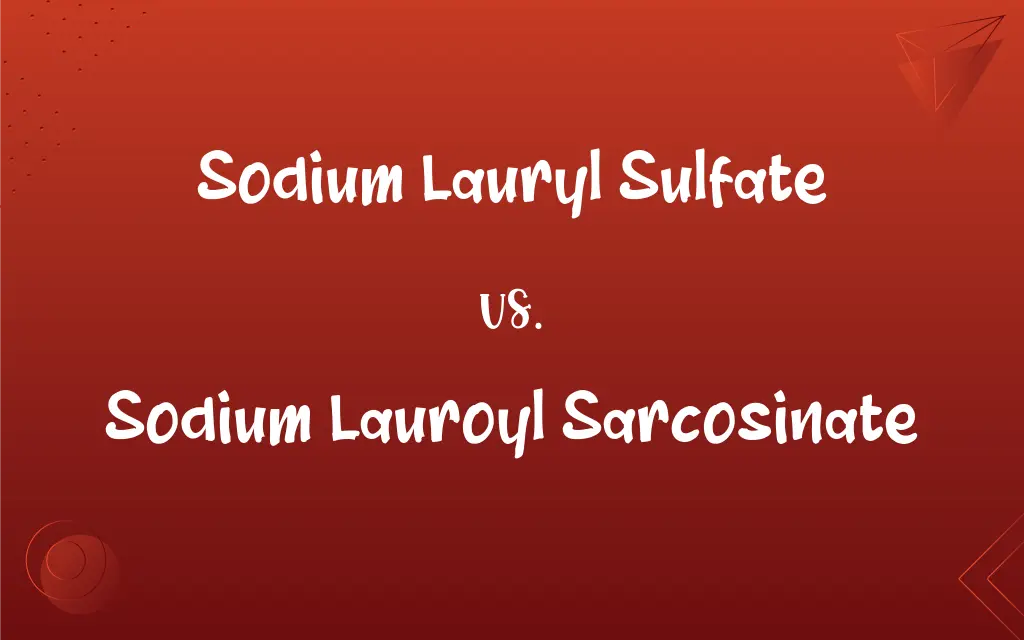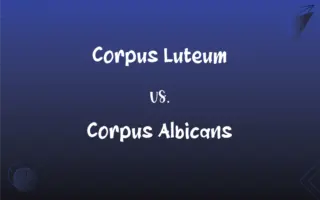Sodium Lauryl Sulfate vs. Sodium Lauroyl Sarcosinate: What's the Difference?
Edited by Aimie Carlson || By Janet White || Published on November 1, 2024
Sodium lauryl sulfate (SLS) is a harsh detergent used in cleaning products for its foaming properties, while sodium lauroyl sarcosinate is a milder, skin-friendly detergent used in personal care products.

Key Differences
Sodium lauryl sulfate (SLS) and sodium lauroyl sarcosinate are both surfactants used in various cleaning and personal care products, but they differ significantly in their properties and applications. SLS is known for its strong cleaning power and ability to create a rich lather, making it a popular choice in shampoos, toothpastes, and laundry detergents. On the other hand, sodium lauroyl sarcosinate is considered a gentler alternative to SLS. It is derived from sarcosine, a natural amino acid, which contributes to its mildness. Sodium lauroyl sarcosinate is often used in formulations designed for sensitive skin or in products that require a gentle but effective cleansing action, such as facial cleansers and baby shampoos.
SLS effectively removes oils and dirt, its high detergency can disrupt the skin's natural lipid layer, leading to potential irritation and dryness. This has led to a demand for milder surfactants like sodium lauroyl sarcosinate, especially in products intended for frequent or delicate use. Sodium lauroyl sarcosinate's compatibility with the skin makes it a preferred choice in premium and sensitive skin care formulations.
The environmental impact and biodegradability of these compounds are also considered in their application. SLS, being more widely used and produced, has been scrutinized for its environmental footprint. In contrast, sodium lauroyl sarcosinate is often touted for its more favorable environmental profile, aligning with the increasing consumer preference for eco-friendly and sustainable products.
Both sodium lauryl sulfate and sodium lauroyl sarcosinate serve as surfactants in personal care and cleaning products, their differences in harshness, suitability for sensitive skin, and environmental impact distinguish their use in formulations. Consumers and formulators alike choose between these ingredients based on the desired product performance, user skin type, and environmental considerations.
Comparison Chart
Origin
Synthetic detergent derived from petroleum or plant sources
Derived from sarcosine, a natural amino acid
ADVERTISEMENT
Harshness
Known for being harsher on the skin and hair
Milder and considered more skin-friendly
Application
Used in a wide range of cleaning products for its strong surfactant effect
Preferred in products designed for sensitive skin due to its gentleness
Environmental Impact
Higher environmental concerns due to production and biodegradability
Better environmental profile, more biodegradable
Suitability for Sensitive Skin
Less suitable due to potential for irritation and dryness
More suitable for sensitive skin, less likely to cause irritation
Sodium Lauryl Sulfate and Sodium Lauroyl Sarcosinate Definitions
Sodium Lauryl Sulfate
Known for its environmental concerns regarding production and biodegradability.
The use of sodium lauryl sulfate in products has raised questions about its ecological impact.
ADVERTISEMENT
Sodium Lauroyl Sarcosinate
Provides good foaming properties without harsh effects.
The mild foam of sodium lauroyl sarcosinate makes it a favorite in premium personal care products.
Sodium Lauryl Sulfate
A surfactant used for its strong cleansing and foaming properties.
Sodium lauryl sulfate is a key ingredient in many commercial shampoos.
Sodium Lauroyl Sarcosinate
Preferred in eco-friendly and sustainable product formulations.
Sodium lauroyl sarcosinate's biodegradability is valued in green cosmetics.
Sodium Lauryl Sulfate
Widely used in personal care and household cleaning products.
Sodium lauryl sulfate is found in toothpaste to create foam and enhance cleaning.
Sodium Lauroyl Sarcosinate
A milder detergent derived from natural amino acids.
Sodium lauroyl sarcosinate is often used in facial cleansers for its gentle cleansing action.
Sodium Lauryl Sulfate
Can cause dryness and irritation in sensitive individuals.
Products containing sodium lauryl sulfate may not be suitable for all skin types.
Sodium Lauroyl Sarcosinate
Suitable for sensitive skin, less likely to cause irritation.
Baby shampoos frequently contain sodium lauroyl sarcosinate due to its mildness.
Sodium Lauryl Sulfate
A synthetic detergent known for removing oils and dirt effectively.
The cleaning power of sodium lauryl sulfate makes it popular in laundry detergents.
Sodium Lauroyl Sarcosinate
Enhances the skin-feel of products without compromising the skin barrier.
Sodium lauroyl sarcosinate is chosen for sensitive skin formulations for its compatibility with the skin's natural moisture.
FAQs
Why choose sodium lauroyl sarcosinate over SLS?
For its mildness, especially in products for sensitive skin or daily use.
Why is SLS considered harsh?
It can strip natural oils, leading to dryness and irritation.
What is sodium lauryl sulfate?
A strong synthetic surfactant used for its cleansing and foaming properties.
Can SLS cause skin irritation?
Yes, especially in individuals with sensitive skin.
What is sodium lauroyl sarcosinate?
A mild detergent derived from natural amino acids, suitable for sensitive skin.
Is sodium lauroyl sarcosinate eco-friendly?
It is considered more biodegradable and environmentally friendly than SLS.
Where is SLS commonly found?
In shampoos, toothpastes, and cleaning products.
Where is sodium lauroyl sarcosinate used?
Primarily in personal care products like facial cleansers and baby shampoos.
Is sodium lauroyl sarcosinate more expensive than SLS?
Generally, yes, due to its derivation from natural amino acids and milder properties.
Is sodium lauryl sulfate bad for the environment?
It has raised environmental concerns due to its production process and biodegradability.
Can SLS be replaced by sodium lauroyl sarcosinate in all formulations?
Yes, for a milder product, but the overall formulation may need adjustment for performance.
Do both surfactants produce foam?
Yes, but sodium lauroyl sarcosinate is less harsh and produces a gentler foam.
Do both ingredients clean effectively?
Yes, but SLS is stronger and may be more stripping than sodium lauroyl sarcosinate.
Why do some consumers avoid SLS in products?
Due to concerns about skin irritation, dryness, and environmental impact.
Are there natural alternatives to these surfactants?
Yes, many natural surfactants are used in organic and natural formulations.
Can sodium lauroyl sarcosinate be used in toothpaste?
Yes, it can be used as a milder alternative to SLS for those with sensitive mouths.
How does sodium lauroyl sarcosinate benefit sensitive skin?
By providing gentle cleansing without disrupting the skin's natural barrier.
Can I find SLS-free products easily?
Yes, many brands now offer SLS-free options, especially in natural and organic product lines.
Is sodium lauroyl sarcosinate safe for all hair types?
Yes, it is considered gentle and suitable for all hair types, including colored and treated hair.
How can I identify these ingredients in products?
By reading the ingredient list on product labels.
About Author
Written by
Janet WhiteJanet White has been an esteemed writer and blogger for Difference Wiki. Holding a Master's degree in Science and Medical Journalism from the prestigious Boston University, she has consistently demonstrated her expertise and passion for her field. When she's not immersed in her work, Janet relishes her time exercising, delving into a good book, and cherishing moments with friends and family.
Edited by
Aimie CarlsonAimie Carlson, holding a master's degree in English literature, is a fervent English language enthusiast. She lends her writing talents to Difference Wiki, a prominent website that specializes in comparisons, offering readers insightful analyses that both captivate and inform.







































































